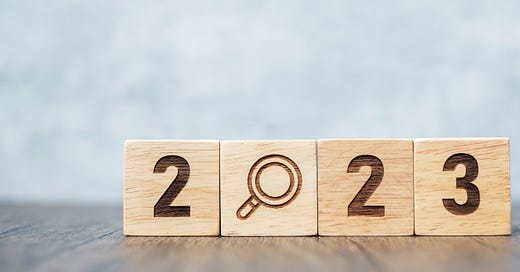Resolutions You Won't Find on Pinterest
Why switching modes in 2023 matters as much as changing habits
Habits are powerful. Humans rarely are. Our lack of sovereignty isn’t always traceable to a lack of willpower. It’s often due to the modes we find ourselves in.
Every January 1, my family spends hours designing goals for the year. All the lap-topping and Notion-ing and Ever-noting and Moleskine-ing—well, it’s very extra, to be honest. Still, this little council of extravagant aspiration gives us a lot of laughs and not a little hope.
But last year, the month after we’d made our resolutions, a stray email in an inbox flipped us on our backsides. The very day I shared an unexpected job posting with my spouse—I had forwarded the email as a joke, honest!—I came home to find her and one of our daughters on the bedroom floor doing Zillow. A few months later, we and our kids split ourselves up among our sundry institutions scattered across the midwest. It was a crazy season, living in six different rental properties, calling each other at night to share how we felt sad, hopeful, weird, lonely, curious, alienated.
We were resolute, yes, but not necessarily to the resolutions we’d made in January.
Fortunately, a year ago, I did more than make a few resolutions. With the help of a small but mighty team, I also launched this newsletter. And the unpredictable events of the last year have only confirmed why this Substack should be less about forming habits than about switching modes.
What’s the difference?
A habit is a practice you repeat till it’s taken for granted. Regularly cooking and sharing dinner with your significant other requires some habit formation. You have to practice shopping ahead, cutting off work, cutting up vegetables—and you have to keep doing all this until dinner prep and dinnertime fold into the things you simply always do. Here’s a mostly true thing about habits: they can be shared, but they tend to be individualized. If cooking dinner’s going to happen, you have to make it a habit—and so does your partner. And here’s another thing about habits: they tend to be non-transferable: they favor doing the same thing at the same time and in the same place. But maybe the most peculiar thing about habits is that they have to become tacit, unnoticed, and hard to explain.
Habits are like stock photos: you’re rarely clear on where they came from.
A mode, on the other hand, is a transferable zone of feeling. Communication scholars and sociologists call modes collective affective spaces. Here’s an example. Your dinner table is a site for habits, but it’s also a place where your favorite modes become visible. If you work remotely, your table makes visible a mode of Getting Sh*t Done. Just look at all those legal pads, file folders, pens, laptop, phone. As you spread all that stuff out and get to work, you overlay the table with a set of job-related vibes. But your table also makes visible a mode of Having a Lot of Fun, as when you spread a puzzle out and start bending over it with your friends. A table can also be a site for a mode for Fixing Things around the House, as when you tear apart the toaster oven, spreading its parts across the table so you can, eventually, turn off the beeper that’s always letting everybody know when you’re just trying to heat up a piece of pizza.
Think of how it feels to be zeroing out your inbox or putting together a puzzle or fixing a toaster or passing the pasta. You might do all these activities in the same physical space, but the modes that overlay that space are completely distinct. The table’s important, but only as a way to make those modes visible and shareable.
Modes tend to be collective, which is another way of saying they have rules. They’re kind of like games in that respect. You can play them almost anywhere, so long as you know the rules. You better not pull out your laptop to answer a few emails between meal courses, and you better not stuff mostaccioli in your mouth during a remote call with your manager. Both activities can be done pretty much anywhere, but you have to pay attention to the collectivity of the modes to know when to do each.
And here, in the unlikely event that you don’t know what a crowded kitchen table looks like, is another stock pic.
Eric Jenkins, the scholar who first got me thinking about this stuff, writes in his most recent book, that modes are ways of coping. And ways of coping can be good or bad. I write this newsletter about rising professionals and for rising professionals, because I believe they’re especially good at noticing the workplace modes we resort to when we feel scattered, confronted, gaslighted, perplexed at work. My hunch, based on this research, is that we when we feel these feelings, we resort to various modes of communication to cope.
Feeling scattered? Try a mode of conspicuous productivity like Zeroing the Inbox.
Feeling confronted? Try a mode of dialogue called Getting on the Same Page.
Feeling perplexed? Try a mode of ridding misunderstanding by Defining Terms.
Sometimes these modes work well. Sometimes they end up making you tired. In any case, modes matter a lot and they can be hard to make sense of—which is why, as with last year’s newsletters, I’ve scheduled conversations with Gen Zs and young millennials. I talk to them, because I have a hunch they have things to say about those times when a mode feels good to you but ends up being bad for you.
The upshot of all this, I think, is that modes might just require some mid-to-late January resolution-making for the upcoming year. To begin to make that argument work in this newsletter, I can’t appeal to a bunch of stories from early-career professionals, because I’m just getting started on the data archive of interview data for 2023. So, instead of sharing a story from an early careerist, let me share an example from a hilarious, horrifying flick, Boots Riley’s 2018 film Sorry to Bother You.
In some ways, it’s a hard movie to watch. Sorry to Bother You is crass, alienated, clever, despairing—and it features images I wish I could un-see. But there’s one interaction I don’t want to forget. Near the start of the film, a young African American telemarketer (played by LaKeith Stanfield) can’t get anybody to take his calls. One cubicle over, an older professional (played by Danny Glover), turns and tells the kid, “Use your white voice.” When Stanfield’s character Cassius asks what that is, the oldster responds, “It’s about sounding like you don’t have a care. Like your bills are paid and you’re happy about your future and you’re about to jump in your Ferrari when you get off this call.”
The white voice the film is making audible is a mode of coping, especially by doing what the folks in power want by trying to sound like uncanny versions of the folks in power.
If Riley’s film is right, the white voice is a mode that’s bad for everybody, whatever their skin color.
Part of what this movie argues is that, whatever your ethnicity or gender or sexuality, you will be asked to engage in modes that make your organization money, even if those profits come at the expense of your wellbeing and your community. I think that’s wisdom worth carrying into this year. I also think it’s a place where you want to make some resolutions with your coworkers about the modes you’re willing to engage and those you’re not.
I should add that my least favorite thing about Sorry to Bother You is its despair about collective action. (For an alternate account, check out Spike Lee’s The BlacKkKlansman.) I agree with Riley’s film that no one employee is in charge of workplace modes. When you get hired and clock in, you immediately encounter all these weird emotional games—and you can’t change them with the flip of a New Year’s Resolution. But that’s not the end of the story.
You can also start doing the modes weird. Let’s say your company places high value on Zeroing Your Inbox. If you want to play the productivity game in this particular job, in other words, you pretty much have to be emailing all the time. That can be energizing; it can also be steadily, gradually exhausting. But how about this: make a resolution to treat every other email that you send and every other email that you get as gift. The missives may not actually be gifts in a glib Happy-Birthday sense. But reimagining email as gift—just think of all the strange and subtle tact required by gift-giving!—is a way to low-key jank the mode of hyperactive sending.
Or what about this: let’s say your company’s dominant mode is feisty and confrontational. Everything’s highly competitive, pushing the limits of cordiality. In an organization where every project has the vibe of a professional wrestling match, you’ll have to engage that high-octane stuff under the bright lights just to keep the job. But try adjusting the mode a bit by displaying admiration for who others are. I’m not talking about being a simp or a sycophant. But you can make things beneficially strange simply by showing respect for other people’s core dignity.
And here’s one more: there’s been talk, a lot of talk, about artificial intelligence at work. When we engage overwhelming digital technologies, it’s easy to find ourselves in a mode of blunt opposition for the sake of personal efficiency. I just need to somehow bludgeon the right keystroke till I get what I need. But try weirding the mode by showing tact and respect for machines. Ezra Klein got me thinking about this when he showed compassion for systems designed to want something—only to have these wants endlessly deferred by silly human experiments. Janking the mode in this way might have human-to-human benefits: does the voice you use with machines affect the voices you use with people? Sure it does. Does being rude to a bot tend to make you rude to—yourself? I suspect so.
Those are some seriously undercooked modal resolutions. But they are intended to get you thinking and cooking on your own. Whaddya say? Are there games you play at work that you want to begin to alter ever so slightly but significantly? Let me know how you think up ways to resolve to do your workplace modes but, as Emily Dickinson might say, do them slant.
Happy Belated New Year!
I’m tickled to be Mode/Switching for another year. Some of this happiness comes from hiring a graphic designer, Sarah Hao, whose work you’ll soon start seeing across these issues. (Give thanks for fewer stock photos…) Some of the happiness comes from January focus groups who have proposed ways to improve the letter. And finally, still more happy feelings come from the Mode/Switch Podcast, which conducts its first capture this upcoming week.
I’m trying to restrain myself from lots of exclamation marks, but my willpower is slipping, so I’ll just stop now and make a last request:
Would you new-year-resolve to share this ‘stack with a rising professional or curious older professional near you?









Yes, I would love that, there is so much communication change in my world from being at UPS World HQ. I started 2019 BC (before covid haha) and now moving from virtual to in-person 60% of my work week. I tried finding your email on LinkedIn but it still has your @trnty.edu.
Great stuff Dr. Mattson, I love your prose and enjoy these articles when they appear in my gmail! Zach